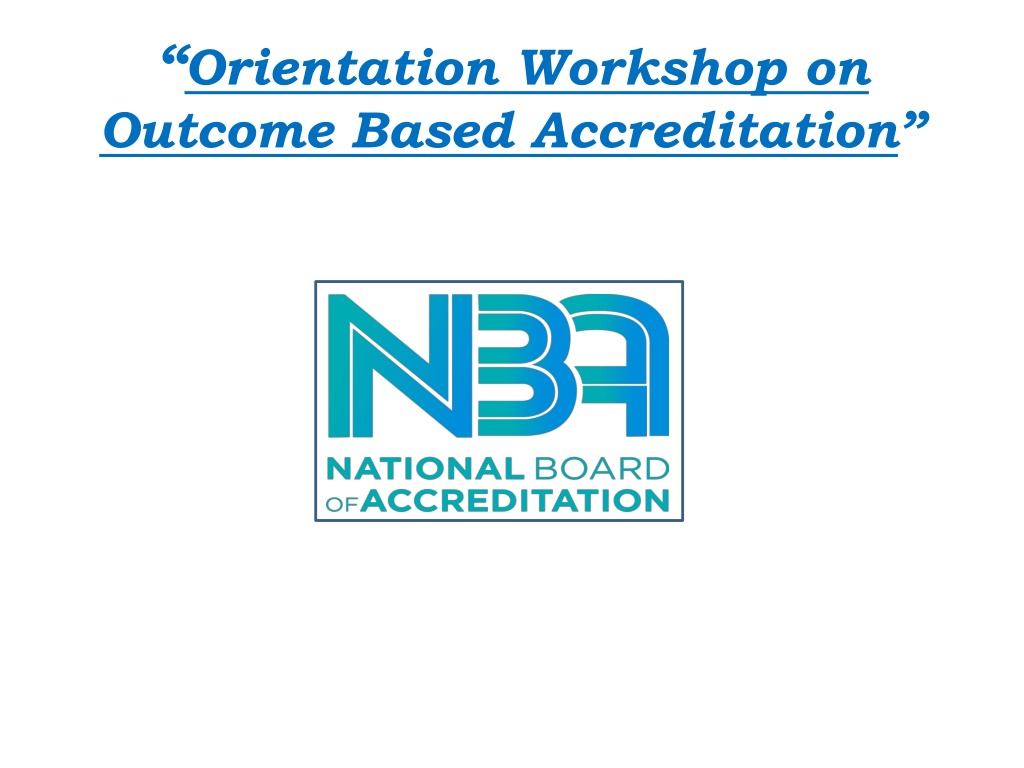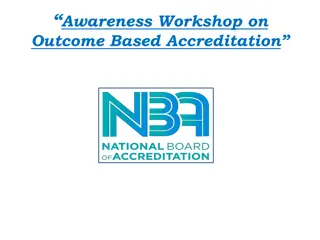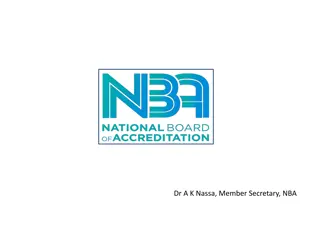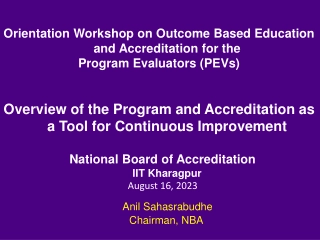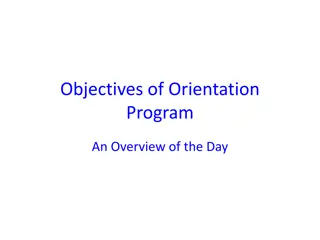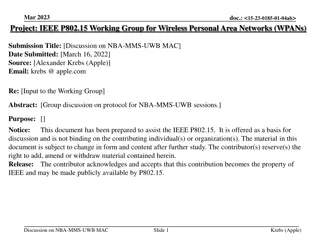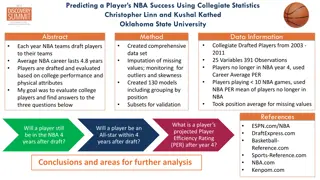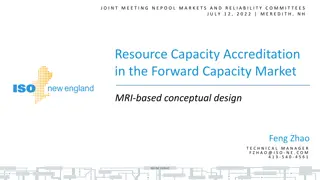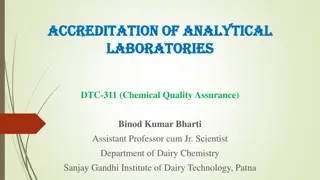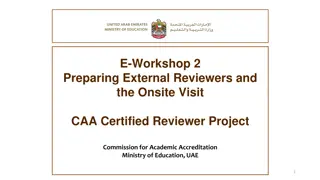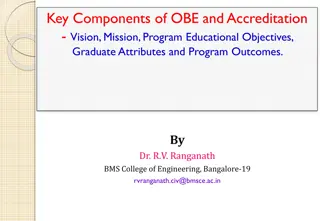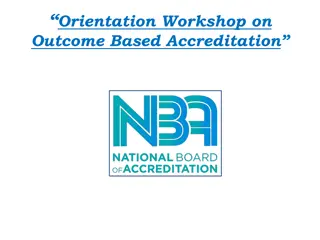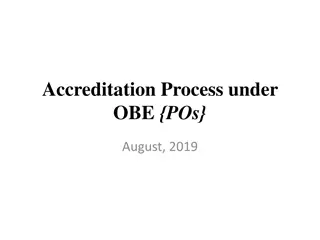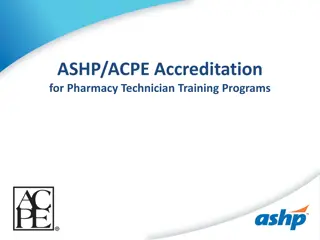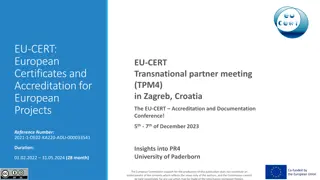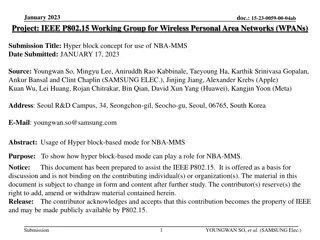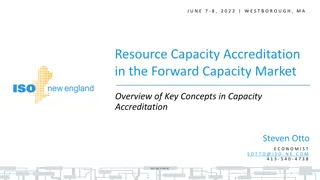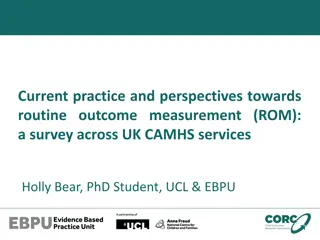Understanding Outcome-Based Accreditation and NBA Accreditation Process
NBA, established in 1994, became autonomous in 2010, aiming for a credible and transparent system of accreditation. Their visit process involves discussions with various stakeholders. Accreditation ensures quality assurance and improvement, recognizing programs that meet standards. It aims to provide feedback for continuous improvement and identify good practices.
Download Presentation

Please find below an Image/Link to download the presentation.
The content on the website is provided AS IS for your information and personal use only. It may not be sold, licensed, or shared on other websites without obtaining consent from the author. Download presentation by click this link. If you encounter any issues during the download, it is possible that the publisher has removed the file from their server.
E N D
Presentation Transcript
Orientation Workshop on Outcome Based Accreditation
ABOUT NBA Established in the year 1994 under Section 10 (u) of AICTE Act. NBA became Autonomous in January 2010 and in April 2013 the Memorandum of Association and Rules of NBA were amended to make it completely independent of AICTE, administratively as well as financially. NBA now independent in its functioning: decision making as well as financially. Does not receive any grant either from the government or from any regulatory body of technical and higher education.
NBA NBA is committed to provide: 1. Credible System of Accreditation 2. Transparent & Accountable System 3
Credible System of Accreditation Strength and credibility of accreditation process largely lies in the integrity, honesty, expertise and professionalism. Evaluators face of NBA. Transparency- Report discussed in the meetings of EAC in presence of all team chair Recommendations of EAC are considered in Sub-committee of AAC Copy of the report is sent to the Institution Change in decision communicated to the institution with reasons 360 degree feedback 4
VISIT During the two and a half day visit, the team has discussions with 1. the Head of the Department /Program and course coordinators 2. a member of the management (to discuss how the program fits into the overall strategic direction and focus of the institution and management support for continued funding and development of the program) 3. faculty members 4. alumni 5. Students 6. Employers institute/Dean/Heads of 5
Accreditation Accreditation is a process of quality assurance and improvement, whereby a program in an approved Institution is critically appraised to verify that the program continues to meet and/or exceed the Norms and Standards prescribed by regulator from time to time. It is a kind of recognition which indicates that a program fulfills desired standards.
WHAT IS NOT THE PURPOSE OF ACCREDITATION Not to find faults with the institution but to assess the status- ante of the performance. Not to denigrate the working style of the institution and its programs but to provide a feed back on their strengths and weaknesses. Not to demarcate the boundaries of quality but to offer a sensitizing process for continuous improvement in quality provisions. Not to select only institutions of national excellence but to provide benchmarks of excellence and identification of good practices.
General Policy on Accreditation The following general policies are the guiding principles for the accreditation of programs: 1. Programs, and not Educational Institutions, are considered for accreditation. 2. Programs from which at least two batches of students have graduated are considered for accreditation.
What is Outcome based Education? 1. what the students need to learn? 2. What the students should demonstrate to the professional world? 3. Accordingly designing both curricula and delivery mechanisms(teaching strategies) to build the required skills and competence.
Outcome-based Program Accreditation Knowledge and competencies profiles Graduate attributes which form the student learning outcomes: Engineering knowledge Problem analysis Design/development of solutions Investigation Modern tool usage The engineer and society Environment and sustainability Ethics Individual and team work Communications Project management and finance Life-long learning
NBA Outcome Based Accreditation Two Tier System Introduction of Two-Tier System based on Types of Institutions. The engineering/technology programs offered by academically autonomous institutions and by university departments and constituent colleges of the universities. Tier I documents: applicable to the Tier-II documents: for non-autonomous institutions, i.e., those colleges and technical institutions which are affiliated to a university. For both: Same set of criteria have been prescribed for accreditation.
Marks Comparison of SAR of UG Engineering Tier-I & Tier II UG Engineering S.No. Criteria Tier-I Tier-II 1. Vision, Mission and Program Educational Objectives 50 60 2. Program Curriculum and Teaching Learning Processes 100 120 3. Course Outcomes and Program Outcomes 175 120 4. Students Performance 100 150 5. Faculty Information and Contributions 200 200 6. Facilities and Technical Support 80 80 7. Continuous Improvement 75 50 8. First Year Academics 50 50 9. Student Support Systems 50 50 10. Governance, Institutional Support and Financial Resources 120 120 1000 TOTAL 1000
Tier I Grades 75% & Above Y 60% and <75% C 40% and <60% W <40% D
POSTGRADUATE ENGINEERING SAR Criteria Criteria Mark/Weightage No. Department Level Criteria 1. 125 Program Curriculum and Teaching Learning Processes 2. 75 Program Outcomes 3. 75 Students Performance 4. 75 Faculty Contributions 5. 75 Laboratories and Research Facilities 6. 75 Continuous Improvement Total 500
Award of Accreditation-Tier-I (UG) Full Accreditation for Six years will be accorded to a program on fulfilment of the following requirements : There should not be any Deficiency or Weakness in any of the criteria and at least seven criteria must be fully compliant with only Concerns in the remaining criteria. Number of available Ph.D. in the department should be greater than or equal to 30 per cent of the required number of faculty averaged over two academic years i.e. Current Academic Year (CAY) and Current Academic Year Minus One (CAYM1). The admissions in the UG program under consideration should be more than or equal to 75 per cent and admissions at the overall institutional level should be more than or equal to 60 per cent, averaged over three academic years i.e. Current Academic Year (CAY), Current Academic Year Minus One (CAYM1) and Current Academic Year Minus Two (CAYM2). Faculty Student Ratio in the department should be less than or equal to 1:15 averaged over three academic years i.e. Current Academic Year (CAY), Current Academic Year Minus One (CAYM1) and Current Academic Year Minus Two (CAYM2).
At least 2 Professors or 1 Professor and 1 Associate Professor (on regular basis) with Ph.D. degree should be available in the respective department for two academic years i.e. Current Academic Year (CAY) and Current Academic Year Minus One (CAYM1). HoD of the program under consideration should possess Ph.D. degree in the Current Academic Year (CAY) #Y shall be >=7, #W and #D shall be Zero (0), where the symbol # has been used to indicate the count.
Full Accreditation for six years may be considered for a program after three months: #Y shall be greater than or equal to 07 #C shall be less than or equal to 02 #W shall be less than or equal to 02 #D shall be zero. The institution is required to submit a compliance report to NBA describing action taken in response to the identified Weakness(es) and Concerns .
Accreditation for Three years will be accorded to a program on fulfilment of the following requirements: #Y shall be greater than or equal to 04 #D shall be less than or equal to 02 The admissions in the UG program under consideration should be more than or equal to 60 per cent and admissions at the overall institutional level should be more than or equal to 60 per cent, averaged over three academic years i.e. Current Academic Year (CAY), Current Academic Year Minus One (CAYM1) and Current Academic Year Minus Two (CAYM2). At least 2 Professors or 1 Professor and 1 Associate Professor (on regular basis) with Ph.D. degree should be available in the respective department for two academic years i.e. Current Academic Year (CAY) and Current Academic Year Minus One (CAYM1). The faculty student ratio in the department under consideration should be less than or equal to 1:25 averaged over three academic years i.e. Current Academic Year (CAY) , Current Academic Year Minus One (CAYM1) and Current Academic Year Minus Two (CAYM2)
Number of available Ph.D. in the department should be greater than or equal to 20 per cent of the required number of faculty averaged over two academic years i.e. Current Academic Year (CAY) and Current Academic Year Minus One (CAYM1). HoD of the program under consideration should possess Ph.D. degree in the Current Academic Year (CAY). In case of a D in Criterion V (Faculty Information & Contributions), the program is not considered for accreditation.
No Accreditation of the program: If the program fails to meet criteria for award of accreditation for 3 years, the program will not be considered for accreditation.
Award of Accreditation-Tier-II (UG) Full Accreditation for Six years will be accorded to a program on fulfilment of the following requirements: Program should score a minimum of 750 points in aggregate out of 1000 points with minimum score of 60 per cent in mandatory fields (i.e. Criteria 4 to 6). Number of available Ph.D. in the department should be greater than or equal to 30 per cent of the required number of faculty, averaged over two academic years i.e. Current Academic Year (CAY) and Current Academic Year Minus One (CAYM1). The admissions in the UG program under consideration should be more than or equal to 75 per cent and admissions at the overall institutional level should be more than or equal to 50 per cent, averaged over three academic years i.e. Current Academic Year (CAY), Current Academic Year Minus One (CAYM1) and Current Academic Year Minus Two (CAYM2).
Faculty Student Ratio in the department should be less than or equal to 1:15, averaged over three academic years i.e. Current Academic Year (CAY), Current Academic Year Minus One (CAYM1) and Current Academic Year Minus Two (CAYM2). At least 2 Professors or 1 Professor and 1 Associate Professor on regular basis with Ph.D. degree should be available in the respective department for two academic years i.e. Current Academic Year (CAY) and Current Academic Year Minus One (CAYM1). HoD of the program under consideration possesses Ph.D. degree in the Current Academic Year (CAY).
Accreditation for Three years will be accorded to a program on fulfilment of the following requirements: Program should score a minimum of 600 points with atleast 40 per cent marks in Criterion V (Faculty Information and Contributions). The admissions in the UG program under consideration should be more than or equal to 50 per cent and admissions at the overall institutional level should be more than or equal to 50 per cent, averaged over three academic years i.e. Current Academic Year (CAY), Current Academic Year Minus One (CAYM1) and Current Academic Year Minus Two (CAYM2). At least one Professor or one Associate Professor on regular basis with Ph.D. degree is available in the respective department for two academic years i.e. Current Academic Year (CAY) and Current Academic Year Minus One (CAYM1).
The faculty student ratio in the department under consideration should be less than or equal to 1:25, averaged over three academic years i.e. Current Academic Year (CAY), Current Academic Year Minus One (CAYM1) and Current Academic Year Minus Two (CAYM2). Number of Ph.D. available in the department should be greater than or equal to 10 per cent of the required number of faculty, averaged over two academic years i.e. Current Academic Year (CAY) and Current Academic Year Minus One (CAYM1).
No Accreditation of the program: If the program scores less than 600 marks or less than 40% marks in Faculty Information and Contributions (Criterion V) or fails to meet the criteria for award of accreditation for 3 years, the program will not be considered for accreditation.
Award of Accreditation- (PG Engineering New SAR) Full Accreditation for Six years will be accorded to a program on fulfilment of the following requirements: Program should score greater than or equal to 375 with 60 per cent in each criterion. Number of Ph.D. available in the department should be greater than or equal to 30 per cent of the required number of faculty, averaged over two academic years i.e. Current Academic Year (CAY) and Current Academic Year Minus One (CAYM1). Faculty student ratio in the department under consideration should be less than or equal to 1:15, averaged over three academic years i.e. Current Academic Year (CAY), Current Academic Year Minus One (CAYM1) and Current Academic Year Minus Two (CAYM2). At least two Professors or one professor and one associate professor on regular basis with a Ph.D. degree having expertise in the domain of the Program under consideration should be available for two academic years i.e. Current Academic Year (CAY) and Current Academic Year Minus One (CAYM1).
Accreditation for Three years will be accorded to a program on fulfilment of the following requirements: Program should score greater than or equal to 300 with 50 per cent in Criterion IV (Faculty Contribution). At least two Professors or one professor and one associate professor on regular basis with Ph.D. qualification with expertise in the domain of the Program under consideration should be available for two academic years i.e. Current Academic Year (CAY) and Current Academic Year Minus One (CAYM1). The department should have at least two faculty having Ph.D. qualification for two academic year i.e. Current Academic Year (CAY) and Current Academic Year Minus One (CAYM1). Faculty Student Ratio in the department under consideration should be less than or equal to 1:25, averaged over three academic year i.e. Current Academic Year (CAY), Current Academic Year Minus One (CAYM1) and Current Academic Year Minus Two (CAYM2).
No Accreditation of the program: Below 300 marks
Pre-Qualifiers (TIER-II) Pre Visit Qualifiers Current Status S.N. Compliance Status Complied/Not Complied Essential qualifiers 1 Vision, Mission & PEOs i. Are the Vision & Mission of the Department stated in the Prospectus / Website? ii. Are the PEOs of the Program listed in the Prospectus / Website? 2 Whether approval of AICTE for the programs under consideration has been obtained for all the years including current year 3 Whether admissions in the undergraduate programs at the Institute level has been more than or equal to 50% *average of the CAY, CAYm1 and CAYm2. 4 Whether admissions in the undergraduate programs under consideration has been more than or equal to 50% **average of the CAY, CAYm1 and CAYm2.
5 Whether faculty student ratio in the department under consideration is better than or equal to 1:25 average of CAY, CAYm1 and CAYm2. % Admission 6 Whether at least one Professor or one Associate Professor on regular basis with Ph.D. degree is available in the respective Department during CAY and CAYm1. SFR 7 Whether number of available Ph.Ds. in the department is greater than or equal to 10% of the required number of faculty average of CAY and CAYm1. 8 Whether two batches have passed out in the programs under consideration *Total number of students admitted in first year minus number of students migrated to other institutions, plus the number of students migrated to this institution divided by the sanctioned intake. **Total number of students admitted in first year in the respective program minus number of students migrated to other programs/ institutions plus the number of students migrated to this program divided by the sanctioned intake in the respective program.
Pre-Qualifiers (TIER-I) S.N. Pre Visit Qualifiers (Average of Assessment years) Current Status Compliance Status Complied/Not Complied Essential qualifiers 1 Vision, Mission & PEOs i. Are the Vision & Mission of the Department stated in the Prospectus / Website? ii. Are the PEOs of the Program listed in the Prospectus / Website? 2 Whether approval of the competent authority (Approval of AICTE/ UGC/ BoG of Universities/ Deemed Universities etc.) for the programs under consideration has been obtained for all the years including current year 3 Whether admissions in the undergraduate programs at the Institute level has been more than or equal to 60%*averaged for CAY, CAYm1 and CAYm2 4 Whether admissions in the undergraduate programs under consideration has been more than or equal to 60%** averaged for CAY, CAYm1 and CAYm2. % Admission 5 Whether faculty student ratio in the department under consideration is better than or equal to 1:25 averaged over CAY, CAYm1 and CAYm2 SFR
6 Whether at least two Professors or one Professor and one Associate Professor on regular basis with Ph.D. degree is available in the respective Department for CAY and CAYm1. 7 Whether number of available PhDs in the department is greater than or equal to 20% of the required number of faculty averaged for CAY and CAYm1. 8 Whether two batches have passed out in the programs under consideration 9 Whether HODs possess Ph.D. degrees for the programs under consideration *Total number of students admitted in first year minus number of students migrated to other institutions, plus the number of students migrated to this institution divided by the sanctioned intake. **Total number of students admitted in first year in the respective program minus number of students migrated to other programs/ institutions plus the number of students migrated to this program divided by the sanctioned intake in the respective program.
Pre-Qualifiers (PG) Compliance Status Complied/Not Complied Sr. No. Pre Visit Qualifiers Current Status Whether accredited by NBA. corresponding UG Program is 1 In case of Tier I, whether the corresponding UG Engineering program has been granted at least 3 Compliances (Y) in SAR with 9 criteria and at least 4 Compliances (Y) in SAR with 10 criteria or In case of Tier II, whether the corresponding UG Engineering program has been granted at least 650 marks out of 1000. 2 Whether the at least two Professors or one Professor and one Associate Professor with Ph.D. qualification (on a full-time/regular basis) having expertise in the domain of the Program under consideration during CAY and CAYm1. Also, provide the name of the professor and associate professor concerned. 3
Whether the department have at least two faculty having Ph.D. qualification during the CAY and CAYm1 4 Whether faculty student ratio in the department under consideration is better than or equal to 1:25 averaged over CAY, CAYm1 and CAYm2. 5 Note: Point No. 1 & 2 above will not be applicable to the Post Graduate Program, that do not have corresponding Under Graduate Program.
Guidelines for Faculty: The faculty to be counted as regular faculty in the respective year, if the faculty has joined before or on 31st August of the same year and continued till 30th April of the subsequent year. The contractual faculty (doing away with the terminology of visiting/adjunct faculty, whatsoever) who have taught for 2 consecutive semesters in the corresponding academic year on full time basis shall be considered for the purpose of calculation in the Student Faculty Ratio. The PhD faculty count requirement shall be calculated on the pro-rota basis with at least 75% to be part of the regular faculty, and the remaining being part of the contractual* faculty, if any. *(Only those who have taught for consecutive 2 semesters on full time basis) The available and required number of PhD. in the department would be calculated on the average basis for the previous two academic years including the current academic year. The available and required number of PhD. in the department shall be truncated to its nearest lower integer.
If a member of regular or contractual faculty is designated as lecturer, even though holding an M.Tech degree, the same will not be count against the faculty requirements. In the disciplines like MBA or PGDM or specialized areas like Biotechnology, all the qualifications relevant and purposeful to those disciplines need to be considered, in addition to the M.Tech/MBA/PGDM degrees. There is no age limit to the consideration for the emeritus faculty as long as they are physically fit to take classes and engage with students, and are employed on a full time basis. Academic year is considered from July to June. If the SAR is submitted before 30th September, then the CAY shall be the previous academic year and if the SAR is submitted after 30th September, then the CAY shall be the running academic year for the purpose of data consideration and calculations. CAY: Current Academic Year CAYm1: Current Academic Year minus 1 = Current Assessment Year CAYm2: Current Academic Year minus 2 = Current Assessment Year minus1 The year mentioned in the documents is exemplary; institute has to consider the academic years as per the definition of CAY given in the document and according to the prevailing year.
The Student Faculty Ratio considered by NBA: UG Engineering Programs (Tier I & Tier II):- 25:1 for the Accreditation of 3 years and 15:1 for the Accreditation of 6 years. PG Engineering Programs: 20:1 for the Accreditation of 3 years. Diploma Engineering Programs: 30:1 for the Accreditation of 3 years PG Management Programs: 25:1 for the Accreditation of 3 years and 15:1 for the Accreditation of 6 years. UG Pharmacy: 20:1 for the Accreditation of 3 years and 15:1 for the Accreditation of 6 years.
PROCESSFLOWFORTHE COMPLIANCE REPORT Institutions are required to submit compliance report in respect of the programs which have been provisionally accredited for 3 years. These compliance report are to be submitted after the completion of two and half years of Provisional Accreditation. The processing fees for the compliance report is Rs. 2.00 Lac (for the first program) plus (+) Rs. 50, 000/- per additional program plus (+) applicable GST. The visit for the data verification pertaining to compliance report would be done by two member expert team.
